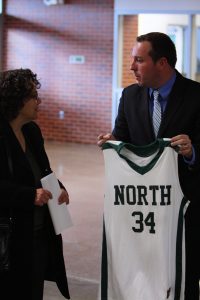Presidential Advisor Looks at DMPS Energy Efficiency Efforts
In President Barack Obama’s State of the Union address on Tuesday night, he reminded Americans that “the easiest way to save money is to waste less energy.” So it’s no coincidence that he dispatched the Chair of his White House Council on Environmental Quality to visit Des Moines Public Schools.
Nancy Sutley spent this morning touring the newly retooled and rejuvenated North High School and then sat down with a portion of the school’s rapidly growing number of Advanced Placement students for a wide-ranging discussion of everything from renewed school spirit to renewable sources of energy.
Recently completed renovations at North include a geothermal heating and cooling system, the 27th to be installed in district facilities. A year from now the number will be 31.
Asked why Sutley chose to visit DMPS, Bill Good – Chief Operations Officer for DMPS – explained that word is getting around the nation about the district’s exemplary and lengthy record of achievements in energy conservation.
“We get contacts from other districts all the time wanting to know how we’ve done what we’ve done,” Good said. “The community rightly expects their tax dollars to be used efficiently and we take that very seriously. We have found ways to improve learning environments while cutting costs at the same time. We’ve not only saved energy, we’ve saved jobs with our projects, whether it’s teachers in the classrooms or the workmen remodeling them.”
Examples of why DMPS has become, according to Sutley, “a national model” of energy efficiency include the fact that even though 92 percent of district classrooms are now air conditioned, up from 66 percent five years ago, over the same period of time energy costs have dropped by more than $1.4 million. Put another way, air conditioning has increased by 40 percent while energy costs have dropped 20 percent.
“The saved energy costs over that period of time means more resources for educating our kids,” Good points out. “We’ve also earned more than half a million dollars in rebates from MidAmerican Energy.”
The district has achieved an average ENERGY STAR score of 76, up from its baseline score of 54. Between fiscal year 2007-08 and fiscal year 2009-10, DMPS reduced energy use by 60,913 mBtu, preventing the emission of almost 5,700 metric tons of carbon dioxide, or the equivalent to the annual greenhouse gas emissions from more than 1,100 passenger vehicles.
Savings on that scale are why DMPS was recognized by the Environmental Protection Agency (EPA) as an “ENERGY STAR® Leader.” Forty-three district buildings now qualify for Energy Star status.
North is just the latest example of Good’s great plan in action. Improved efficiencies at North have resulted in a 35% reduction in energy costs despite a 10,000 square foot addition and the installation of air conditioning.
Systems are equipped with occupancy sensors. Lights dim when passing periods end and the corridors lined with college pennants are empty. Principal Matt Smith told Sutley “dark, empty hallways equal great academics.”
The AP students who met with Sutley were eager to talk about the changes at North from their perspectives. What they described was a formerly downtrodden place where a newfound pride has sprung up since Smith arrived in the fall of 2010. The geothermal HVAC system isn’t the only new energy source that’s making North cool these days.
A stuffed 1,500 pound polar bear has been on display in the school’s main entrance for decades, but now it’s as much metaphor as mascot. Nothing about the school is endangered anymore except an outdated reputation. During passing periods you can hear the roar that matches the bear’s pose. And even after the lights dim and the roar subsides you can feel a new energy flowing.
North, like the rest of DMPS, is being rebuilt to last.





